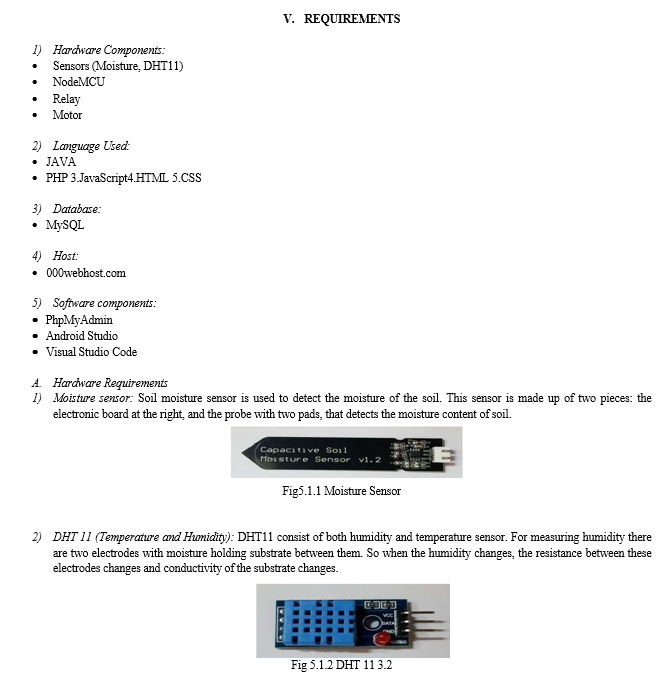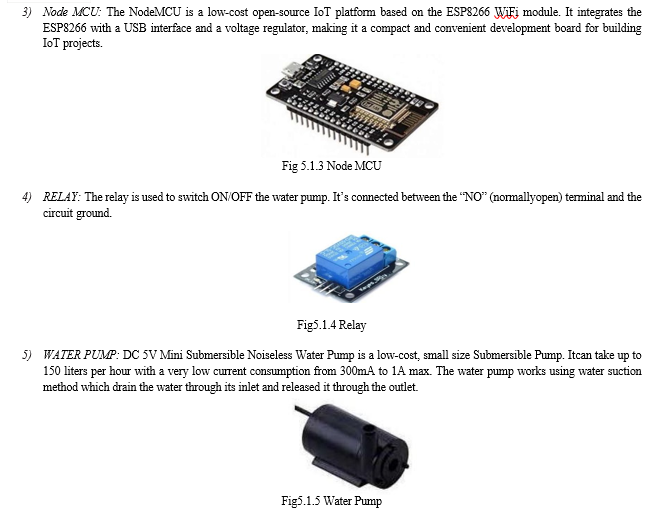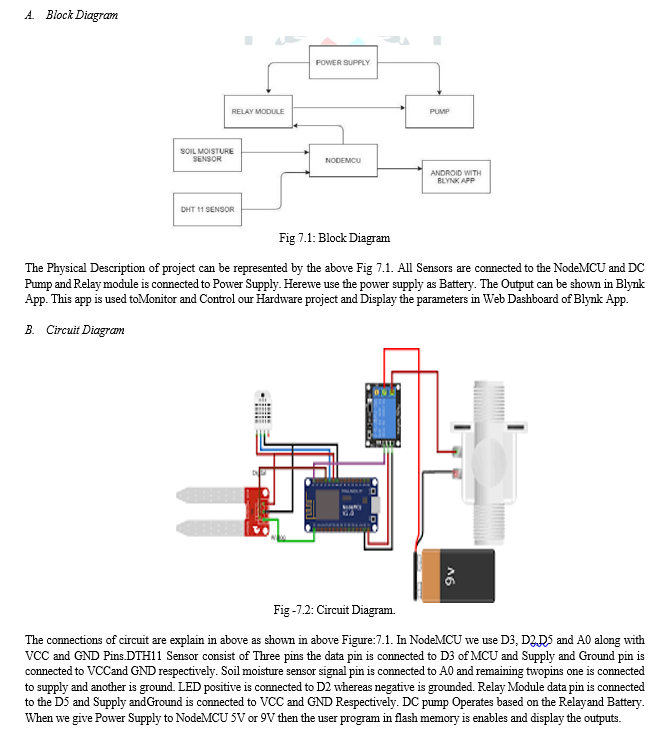Ijraset Journal For Research in Applied Science and Engineering Technology
- Home / Ijraset
- On This Page
- Abstract
- Introduction
- References
- Copyright
IOT Based Smart Plant Monitoring System
Authors: Ayushman Joshi, Sonika T, Tharani M, Jasraj Singh , Prof. Deepa P
DOI Link: https://doi.org/10.22214/ijraset.2024.58953
Certificate: View Certificate
Abstract
The IoT-based Smart Plant Monitoring System represents a transformative approach to modern agriculture by leveraging the power of the Internet of Things (IoT) to enhance the monitoring and management of plants in agricultural settings. This system integrates advanced sensor technologies, wireless communication, and data analytics to provide real-time insights into the health and environmental conditions of plants, thereby optimizing resource utilization and improving overall crop yield. The key components of the proposed system include a network of sensors strategically placed within the agricultural field to capture vital data related to soil moisture, temperature, humidity, light intensity, and nutrient levels. These sensors are connected through IoT-enabled devices, forming a cohesive network that continuously collects and transmits data to a centralized cloud-based platform. The cloud platform acts as a repository for the acquired data, where advanced analytics algorithms process the information in real-time.
Introduction
I. INTRODUCTION
The Internet of Things (IoT) has emerged as a transformative force across various industries, and agriculture is no exception. In the context of modern farming, the integration of IoT technologies has given rise to innovative solutions aimed at optimizing crop management and resource utilization.
Traditional farming practices often rely on manual observations and historical knowledge to make decisions about irrigation, fertilization, and pest control. However, these methods can be imprecise and may not fully account for the dynamic and often unpredictable nature of environmental conditions.
A. Scope
An IoT-based smart plant monitoring system has a broad scope, offering several opportunities for development and innovation. The scope of such a project can encompass various aspects, including hardware design, software development, data analytics, and user interfaces.
II. PROBLEM DEFINITION
Farmers cannot precisely detect environmental condition around the plant. Farmers only know the wetness of soil, the humidity and temperature around the plant by feel it themselves. Nowadays, there is wireless technologies that being implement in many fields. The user need device that can send the condition of plant wirelessly. The user will get notification about the environmental condition around the plant.
Along the course of project completion, we encountered various problems and obstacles. Not everything that we had planned went smoothly during the project development span. Also, we had a limited amount of time for its completion so we were under a certain amount of pressure as well. We had to start from the research phase at the beginning and needed to gain knowledge on all the devices and components that we had intended to use for our project. Other phases of the project included coding, debugging, testing, documentation and implementation and it needed certain time for completion so we really had to manage the limited time available to us and work accordingly to finish the project within the schedule.
By this iot based plant monitoring system we can easily water the crops according to necessity from where ever we are present.
Because we are watering and controlling the soil moisture using specific app in the mobile.
III. LITERATURE REVIEW
Automated plant watering system. Abhishek Gupta [1] They explain that the system consists of a soil moisture sensor, a water pump, and a microcontroller that controls the watering process. The article also discusses the advantages of using an automated system over manual watering, such as improved plant growth and reduced water waste.
Overall, the article presents a useful solution for individuals who want to maintain healthy plants while minimizing their water usage.
Smart garden monitoring system using IOT T. Thamarai Manalan [2]They explain that the system collects data on parameters such as temperature, humidity, soil moisture, and light intensity using sensors and sends the data to a cloud-based server for storage and analysis. The article also describes how the system can be accessed remotely through a mobile application.
Embedded based greenhouse monitoring system using microcontroller. Arul Jai Singh
[3] They presents a system designed to monitor and control the environmental parameters of a greenhouse using an embedded system based on a PIC microcontroller. The authors, Arul Jai Singh, Raviram, and Shanthosh Kumar, explain that the system measures parameters such as temperature, humidity, and light intensity using sensors and adjusts them to maintain optimal conditions for plant growth.
Iot based plant monitoring system. Miss. Prajakta Zodge [4] In India about 35% of land was under reliably irrigated. And the 2/3rd part of land is depending on monsoon for the water. Irrigation reduces dependency on monsoon, improves food security and improves productivity of agriculture and it offers more opportunities for jobs in rural areas. Farmers are facing problems related to watering system that how much water has to supply and at what time? Sometimes overwatering causesthe damage to crops and as well as waste of water. Hence for avoid such damage we need to maintain approximate water level in soil.
IV. PROJECT DESCRIPTION
The IoT-Based Smart Plant Monitoring System is an innovative project aimed at revolutionizing traditional agriculture by incorporating Internet of Things (IoT) . Implement a network of sensors to capture crucial plant and environmental data, including soil moisture, temperature, humidity, light intensity, and nutrient levels. Develop an IoT-enabled infrastructure for seamless communication and data transfer between the deployed sensors and a centralized cloud-based platform. Design a user-friendly interface (e.g., mobile application or web portal) for farmers to access real-time data, receive alerts, and interact with the Smart Plant Monitoring System. Utilize advanced analytics algorithms for real-time data processing, trend analysis, and the generation of actionable insights to support decision-making. Integrate mechanisms for remote control of irrigation systems based on real-time soil moisture data, optimizing water usage. Implement an alerting system to notify farmers of potential issues such as plant stress, diseases, or suboptimal environmental conditions.
A. Proposed Structure
In the field section, various sensors are deployed in the field like temperature sensor, moisture sensor and PIR sensor. The data collected from these sensors are connected to the microcontroller through RS232. In control section, the received data is verified with the threshold values. If the data exceeds the threshold value the buzzer is switched ON and the LED starts to blink. This alarm is sent as a message to the farmer and automatically the power is switched OFF after sensing. The values are generated in the web page and the farmer gets the detailed description of the values. In manual mode, the user has to switch ON and OFF the microcontroller by pressing the button in the Android Application developed. This is done with the help of GSM Module. In automatic mode, the microcontroller gets switched ON and OFF automatically if the value exceeds the threshold point. Soon after the microcontroller is started, automatically an alert must be sent to the user. This is achieved by sending a message to the user through the GSM module. Other parameters like the temperature, humidity, moisture and the PIR sensors shows the threshold value and the water level sensor is used just to indicate the level of water inside a tank or the water resource.
???????B. Assumptions and Dependencies
The system assumes a stable and reliable internet connection for data transmission and communication with the cloud platform.
The sensors used for monitoring plant parameters are assumed to be accurate and calibrated for precise measurements.
Continuous and reliable power supply is available for both the IoT devices and sensors deployed in the plant monitoring system.
Standard security measures (encryption, access controls, etc.) are assumed to be effective in safeguarding the data and system from unauthorized access.
Users are assumed to have basic technical knowledge for system setup, troubleshooting, and interpretation of monitoring data.
The system assumes that the environmental conditions, such as weather and external factors, will not significantly impact the hardware and sensor performance.
The system assumes compliance with relevant regulations and standards for data privacy, environmental monitoring, and IoT device deployment.
Timely and reliable supply of sensors from the chosen supplier is a dependency for the successful implementation of the monitoring system.
The stability of the local power grid is a dependency for ensuring continuous power supply to the IoT devices and sensors.
Approval from relevant regulatory bodies is a dependency for compliance with legal and environmental standards.
The mobile application's compatibility depends on timely updates and support from mobile operating system providers (iOS, Android).


VI. METHODOLOGY
The IoT-based Smart Plant Monitoring System is designed to monitor and maintain the growth and health of plants. The system works by collecting data from various sensors and then sending that data to a mobile application through the internet. The system starts by collecting data from the DHT11 sensor, which measures the temperature and humidity of the environment. The data is then sent to the Arduino microcontroller, which processes the data and sends it to the Blynk app through the ESP8266 Wi-Fi module. The Blynk app then displays the temperature and humidity data in real time. If the temperature or humidity falls outside of a specified range, the Arduino sends a notification to the user’s mobile device or computer. The user can then adjust the settings on the app to optimize the environment for the plants. The solenoid valve is controlled by the Arduino based on the data from the sensors.
VII. DESIGN AND IMPLEMENTATION
An important factor such as temperature and humidity of the environment Can be monitored using DHT 11 The control on the temperature is done using DC motor which acts as cooling mechanism. Temperature and the humidity will be sensed by DHT11 sensor digitally. The CO2 gas will be sensed by the MQ135 sensor and Other MQ sensors is also provided for the knowledge of the different atmosphere released gasses of that surrounding.The ESP8266 microcontroller is used to send all the monitored parameter and different gasses on IoT Cloud using Wi-Fi. And to monitor a moisture in soil the moisture sensor is used and also relay for controlling water pump to maintain the moisture sensor of the soil.
All the sensors are interfaced with ESP8266 micro- controller and regulated DC power supply is used. The water level in the soil is detected using the soil moisture detector and further actions are taken accordingly.

VIII. EXPERIMENTATION
- The experimentation starts by assembling the components required (WIFI chip, sensors, battery, motor, jumper wires, etc.) in the breadboard.
- Then we connect the USB cable to our laptop or monitor where we can set up the codes and run the codes in a free application named Arduino IDE which helps in operating various MCUs.
- In the website we can setup the required criteria such as temperature, moisture, etc and connect it to the specific code segment that is going to track the values.
- The interface is then created showing us the criteria that we inserted and is displayed in a meter like image showing the exact calculations below it.
- Then we can put the sensors in agricultural soil sample and operate the system.
- Once we are sure that the system has no problems whatsoever and is tracking the required data smoothly we can connect the system data to our mobile application that is BLYNK app, leading to monitoring and operating the system with our mobile device.
IX. DELIVERABLES
Through the integration of various sensors such as humidity, temperature, soil moisture, light intensity, and even nutrient levels, the system offers a comprehensive view of the plant's environment.
This data is then collected and transmitted to a centralized platform or application, which can be accessed by users from anywhere at any time.
The benefits of such a system are numerous:
Optimized plant growth Resource efficiency Remote monitoring Early detection of issues Data-driven insights Education and research
However, it's important to acknowledge some potential challenges:
Data security: given that the system relies on data transmission and storage, ensuring data security and privacy is crucial to prevent unauthorized access or breaches.
Technical expertise: users may require a certain level of technical knowledge to set up and maintain the system effectively.
Reliability: the system's reliability depends on stable internet connectivity. Any disruptions in connectivity could hinder real-time monitoring and intervention.
X. RESULT AND DISCUSSION
The previous work on the monitoring system was automatically switching on the pump taking the other detected factors in account but here in this paper the detection of the hazardous gases is also done where one can get detail information about the atmosphere nearby. As we are aware of the occupations in India, one of the most important occupation is Agriculture which is very time consuming also water requiring occupation. This proposed system is basically used to monitor the important factors of the crops under the unfavorable conditions including the atmospheric conditions. The sensor used will result in giving the values of the important factors including the humidity, temperature, gases of the surrounding which will be taken into consideration in order to reduce the damage to the crop. This will effectively increase the production having quality assurance thus reducing the manpower required.
XI. ACKNOWLEDGEMENT
It is a great pleasure for us to acknowledge the assistance and support of many individuals who have been responsible for the successful completion of this project work.
First, we take this opportunity to express our sincere gratitude to School of Engineering & Technology, Dayananda Sagar University for providing us with a great opportunity to pursue our Bachelor’s degree in this institution.
We would like to thank Dr. Udaya Kumar Reddy K R, Dean, School of Engineering & Technology, Dayananda Sagar University for his constant encouragement and expert advice. It is a matter of immense pleasure to express our sincere thanks to Dr. Girisha G S, Chairman, Dept. of Computer Science and Engineering, Dayananda Sagar University, for providing right academic guidance that made our task possible.
We would like to thank our guide, Prof. Deepa P Assistant Professor, Dept. of Computer Science and Engineering, Dayananda Sagar University, for sparing her valuable time to extend help in every step of our project work, which paved the way for smooth progress and fruitful culmination of the project.
We would like to thank our Project Coordinator Dr. Meenakshi Malhotra and Prof. Mohammed Khurram J as well as all the staff members of Computer Science and Engineering for their support.
We are also grateful to our family and friends who provided us with every requirement throughout the course.
We would like to thank one and all who directly or indirectly helped us in the Project work.
References
[1] Abhishek Gupta, Shailesh Kumawat, Shubham Garg, \"Automated Plant Watering System\", Vol-2, Issue-4, 2016 ISSN: 2454 - 1362.
[2] Taylor Francis Group, \"Automated Plant Watering System\", LLC, pp.59-69, 16 September 2016.Taylor Francis Group,\"Automated Plant Watering System\", LLC, pp.59-69, 16 September 2016.
[3] T.Thamaraimanalan , S.P.Vivekk ,G.Satheeshkumar, P.Saravanan,\" Smart Garden Monitoring System Using IOT\",IEEE,pp.5- 10,2018.
[4] Arul Jai Singh, Raviram, Shanthosh Kumar, \"Embedded Based Green House Monitoring system using pic Microcontroller\", IEEE Trans. Syst, Man, Cybern. Systems and Humans, vol. 41, no. 6, pp.1064-1076, November 2011.
[5] Apeksha Rane, Bhushan Vidhale, Priyanka Hemant Kale,Ganesh Khekare 2022 10th International Conference on Emerging Trends in Engineering and Technology - Signal and Information Processing (ICETET-SIP-22)
[6] Dr.G.Rajakumar , M.Saroja Sankari , D.Shunmugapriya and S.P.Uma MaheswariAsian Journal of Applied Science and Technology (AJAST) (Open Access Quarterly International Journal) Volume 2, Issue 2, Pages 474-480, April-June 2018
[7] Jeremy Maxey-Vesperman, Zachary Goldasich, Girma Tewolde 2019 ieee 16th international conference on smart cities: improving quality of life using ict & iot and ai (honet-ict)
CODE:
#define BLYNK_PRINT Serial
#include
Copyright
Copyright © 2024 Ayushman Joshi, Sonika T, Tharani M, Jasraj Singh , Prof. Deepa P. This is an open access article distributed under the Creative Commons Attribution License, which permits unrestricted use, distribution, and reproduction in any medium, provided the original work is properly cited.

Download Paper
Paper Id : IJRASET58953
Publish Date : 2024-03-12
ISSN : 2321-9653
Publisher Name : IJRASET
DOI Link : Click Here
 Submit Paper Online
Submit Paper Online

